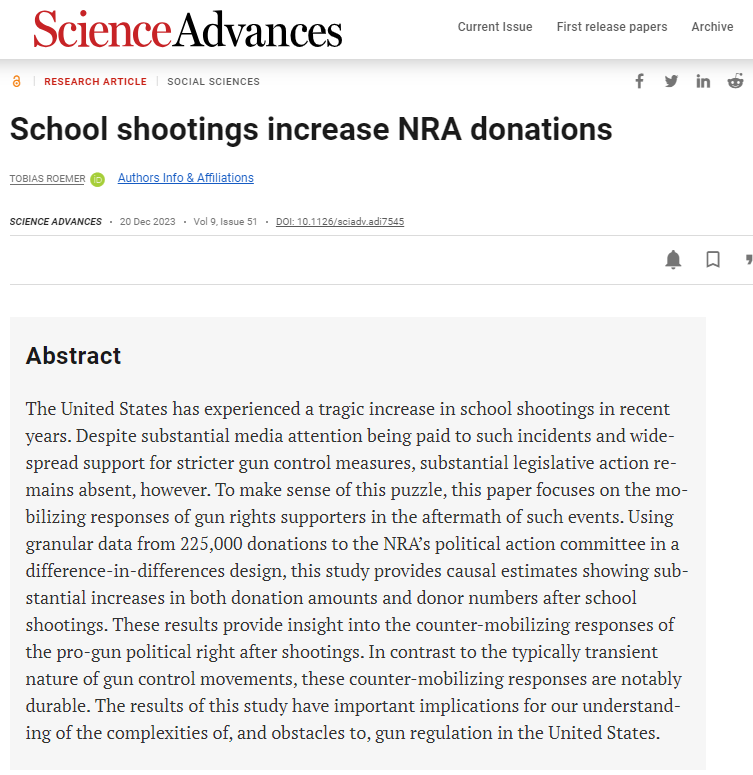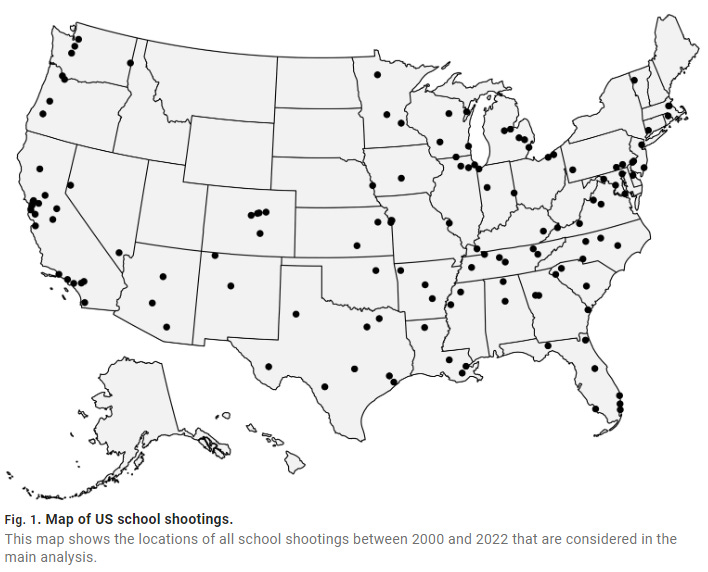K-12 SSDB data used in top academic journal article
Peer-reviewed paper 'School shootings increase NRA donations' appeared this week in Science Advances, one of the top 3 research publications in the world.
For anyone who’s not immersed in the academic world, there are three top tier journals that can define a researcher’s career to have an article published in: Nature, New England Journal of Medicine, and Science Advances.
This week, Tobias Roemer from the University of Oxford published a study of how county-level NRA donations are impacted by school shootings in Science Advances. (Note: the author is from Oxford University in England and has no political affiliations in the United States)
Aside from the connection to school shootings, why am I writing about this paper? Back in February, Dr. Roemer emailed me and requested a copy of my school shooting dataset with thousands of incidents dating back to 1966. I provide this data for free to academic researchers who are studying gun violence at schools. To date, there have been more than 250 research publications with it. This paper in Science Advances is the highest profile publication so far.
Unfortunately, academic papers don’t make much sense to the audience who needs this information about school safety the most—parents, teachers, school administrators, and public officials. Unlike a newspaper article that tells the reader a story, an academic paper is a presentation of the research process that outlines the question, variables, data, methods, analysis, and findings.
As a Ph.D. student, I get assigned dozens (maybe hundreds) of journal articles every semester. To make sense of the research and turn it into something that I can memorize for a comprehensive exam, I write short summaries that break down the pieces.
Breakdown
Research Question: Are county-level NRA donations impacted by a school shooting in that county?
Dependent Variable: County-level NRA donations.
Independent Variable: School shooting or no school shooting in a county.
Data: Custom dataset of school shootings, K-12 School Shooting Database raw data, dataset of county-level NRA donations (required by Federal Election Commission), control dataset of National Right to Life Committee donations (also required)
Methods: Identified school shootings with fatalities in 131 different counties between 2000-2022. For each of those counties, NRA donations before and after the shooting were compared to identify a change.
Analysis: Researchers always need to prove that the independent variable being studied is the variable that is driving the results. To show that other factors beyond the school shooting are not impacting donations, an analysis was also run against a control group of counties that didn’t have a school shooting. To check if there were other conservative political factors at work, county-level donations to anti-abortion groups were compared to the spike in post-school shooting donations. Unlike NRA donations, there was not an increase in anti-abortion donations following a school shooting.
To check for other variables that might be causing this behavior, a county-level analysis of NRA advertising was run to see if there was more exposure to social media ads requesting donations in the counties that experienced a shooting. The analysis also showed that there were not more ads connected to the shooting location.
To check the robustness (strength of effect) of the results showing that shootings and NRA donations were connected, my K-12 SSDB data which includes both high fatality attacks and shootings without injuries (e.g., shots fired but all of the bullets missed) was compared. This analysis found that donations were higher when there were more fatalities showing a strong relationship between the variables.
Findings:
School shootings increase both the dollar amount (30% average increase) and number of donors giving money (40% average increase) to the NRA in counties where a school shooting happened.
These donations are independent of advertising or other conservative causes (e.g., donations to anti-abortion groups) in the affected county.
When there are more fatalities, there is a greater impact on increased donations.
Increased NRA donations continue for years after a school shooting.
The research and analysis in this paper were far more complex than what I included in this basic summary. I encourage you to take a look at the full paper because Tobias Roemer does an amazing job of presenting the evidence, addressing confounding factors, and showing why the findings are valid.
This paper is not political opinions, it’s an evidence-based analysis of data.
Please let me know if you found this summary and breakdown of the research process useful.
David Riedman is the creator of the K-12 School Shooting Database and a national expert on school shootings. Listen to my recent interviews on Freakonomics Radio and the New England Journal of Medicine.








